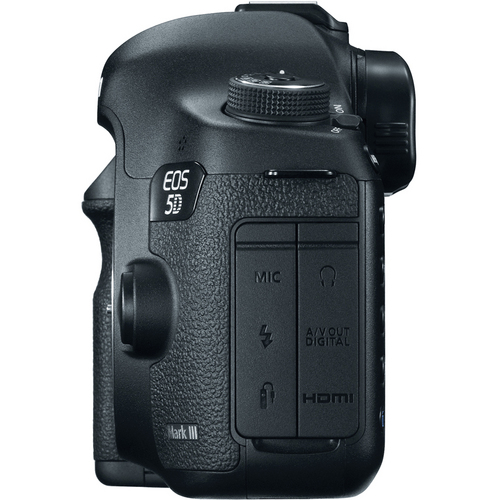Canon EOS 5D Mark III Digital SLRs
Canon EOS 5D Mark III Digital SLRs
USER REVIEWS
|
[Mar 15, 2013]
David Terry
Professional
Strength:
Fast and flexible focus system, excellent low light / high ISO performance, high resolution and excellent quality images.
Weakness:
The auto focus points in the viewfinder are difficult to see in the dark. Sometimes the new flexibility of being able to positing your focus point just about anywhere is a weakness instead of a strength as you can't remember where you placed it and can't see well enough in the dark to know where it is and until you get the focus point over something that it can grab focus on, the focus confirmation won't light up to reveal where it is hiding. Having owned the 5D Mark II and the classic 5D before it, I can say that Canon has remained true to the 5D ideals of full frame and high quality images at an affordable price (for the professional). The 5D Mark III will instantly feel familiar in the hands of one who has used the 5D or 5D Mark II. And yet it brings with it new advanced features such as the fast and flexible 61-point focus system (which is bested only by the much more expensive Canon 1Dx), as well as stratospheric ISOs reaching up to 102,400.
|
|
[Aug 01, 2012]
Bob Scott
Professional
Strength:
Fast autofocus. Better audio controls in video mode, better low light video, 720p 60 frame per second(FINALLY!) and all around images look better.
Weakness:
wish 60fps was full 1080p I happen to be one of those professional photographers waiting for the Mark 3 to come out... and I have to say, I love it. I've been shooting with Mark 2 up until last week when the Mark 3 arrived at my door. After taking out of the box and adding on my 70-200mm f 2.8 to test I noticed right away how much better image quality improved with this camera. Part of that quality sensation was seeing the image preview on the brighter, bigger, better quality back screen. I noticed the faster autofocus especially when using my 70-200mm f 2.8. The manual audio controls and headphone plug was definitely huge missing part of the previous Mark 2 and I'm really happy to see both added into the Mark 3. The low light quality in video mode is definitely a true step up in quality which I will be testing in the days to come. Same goes for the 60fps in video mode. I was always bummed that the lower end 7D had 60 fps and now I can quit my b*tching. Though I wish this could work in full 1080p mode but it's the least of my worries. If I really needed to slow things down there are bigger badder cameras I could rent for such a need. I also really like the ease of access to control for video mode start/stop.
Similar Products Used: Canon 5D Mark 2 |
|
[Jul 26, 2012]
Jeremy Hall
Expert
Strength:
Much improved focusing system over the Mark II. Owners of the 7D will find the options of the focusing system very familiar with perhaps even better precision. My favorite option is the 9 point region unless even more precise selection within the 61-points is needed. I can actually rely on the outer points to catch focus. Low light performance is excellent, with very usable detail even with grain at ISO 6400 and up. The silent shutter was a surprise how quiet it becomes, perfect for performances or other situations where a louder shutter is a distraction. Though there are some slight button changes, the body layout is familiar and once again improved in how solid it feels while in your hands. Two memory slots was a welcome addition for me. Though two CF slots would have been nice from a backup or space standpoint, I have been using the Eye-Fi card for wireless tethering and enjoying what that offers. Customization of buttons and options throughout the menus is expanded, which makes personalizing the way your camera performs even more available. The image detail and quality of the full frame continues to be improved with the added features helping you to maximize your output. I only use mine for video work periodically, but it is still a strong performer building on what the Mark II had to offer.
Weakness:
It's not cheap. Of course if you are using this body professionally it is worth the investment for sure. If you use the SD slot, it has been revealed that your overall write speed is limited as a result. I don't typically use this camera for fast action, but it is something to be aware of. Periodically I get an "Error 80" that requires removing the battery to reset. This error is a result of an issue with the Eye-Fi and seems to happen when the camera has gone to sleep between what you are shooting. As a long time Canon owner, I’ve enjoyed using my Canon 5D Mark II for 3.5 years now, and it is an amazing camera. I love it’s beautiful clear images, smooth bokeh and tremendous file quality. That said, I have been looking forward to the next generation for some time now for some specific improvements. Most notably I was hoping for an improved auto focus system, quieter shutter sound, faster frames per second (FPS) and even better high ISO performance. On all these counts the Canon 5D Mark III has delivered! You can read some of my impressions and sample photos from the first night I received the camera here: http://greatproj.com/2012/04/a-new-tool-in-the-bag-a-practical-review/ The low light performance, both in the image quality and ability to focus, makes this camera a much better tool than it's predecessor. Similar Products Used: Canon 5D Mark II, 40D, 20D, 10D |














